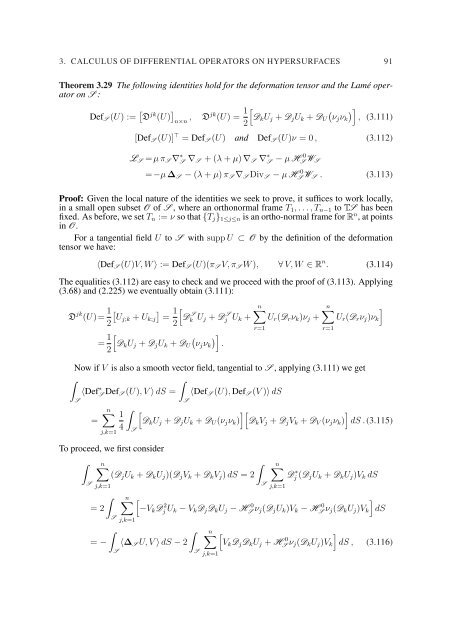EQUATIONS OF ELASTIC HYPERSURFACES
EQUATIONS OF ELASTIC HYPERSURFACES
EQUATIONS OF ELASTIC HYPERSURFACES
Create successful ePaper yourself
Turn your PDF publications into a flip-book with our unique Google optimized e-Paper software.
3. CALCULUS <strong>OF</strong> DIFFERENTIAL OPERATORS ON <strong>HYPERSURFACES</strong> 91<br />
Theorem 3.29 The following identities hold for the deformation tensor and the Lamé operator<br />
on S :<br />
Def S (U) := [ D jk (U) ] , n×n Djk (U) = 1 [<br />
( ) ]<br />
D k U j + D j U k + D U νj ν k , (3.111)<br />
2<br />
[Def S (U)] ⊤ = Def S (U) and Def S (U)ν = 0 , (3.112)<br />
L S =µ π S ∇ ∗ S ∇ S + (λ + µ) ∇ S ∇ ∗ S − µ H 0<br />
S W S<br />
=−µ ∆ S − (λ + µ) π S ∇ S Div S − µ H 0<br />
S W S . (3.113)<br />
Proof: Given the local nature of the identities we seek to prove, it suffices to work locally,<br />
in a small open subset O of S , where an orthonormal frame T 1 , . . . , T n−1 to TS has been<br />
fixed. As before, we set T n := ν so that {T j } 1≤j≤n is an ortho-normal frame for R n , at points<br />
in O.<br />
For a tangential field U to S with supp U ⊂ O by the definition of the deformation<br />
tensor we have:<br />
〈Def S (U)V, W 〉 := Def S (U)(π S V, π S W ), ∀ V, W ∈ R n . (3.114)<br />
The equalities (3.112) are easy to check and we proceed with the proof of (3.113). Applying<br />
(3.68) and (2.225) we eventually obtain (3.111):<br />
D jk (U)= 1 [ ] 1<br />
Uj;k + U k;j =<br />
2<br />
2<br />
= 1 2<br />
[<br />
D S k U j + D S j U k +<br />
[<br />
D k U j + D j U k + D U<br />
(<br />
νj ν k<br />
) ] .<br />
n∑<br />
U r (D r ν k )ν j +<br />
r=1<br />
n∑ ]<br />
U r (D r ν j )ν k<br />
Now if V is also a smooth vector field, tangential to S , applying (3.111) we get<br />
∫<br />
∫<br />
〈Def ∗ S Def S (U), V 〉 dS = 〈Def S (U), Def S (V )〉 dS<br />
S<br />
=<br />
j,k=1<br />
S<br />
n∑<br />
∫<br />
1<br />
[<br />
][<br />
]<br />
D k U j + D j U k + D U (ν j ν k ) D k V j + D j V k + D V (ν j ν k ) dS . (3.115)<br />
4 S<br />
To proceed, we first consider<br />
∫<br />
n∑<br />
S<br />
j,k=1<br />
∫<br />
= 2<br />
∫<br />
(D j U k + D k U j )(D j V k + D k V j ) dS = 2<br />
n∑<br />
S<br />
j,k=1<br />
[<br />
−V k D 2 j U k − V k D j D k U j − H 0<br />
∫<br />
= − 〈∆ S U, V 〉 dS − 2<br />
S<br />
∫<br />
n∑<br />
S<br />
j,k=1<br />
S<br />
j,k=1<br />
r=1<br />
n∑<br />
Dj ∗ (D j U k + D k U j )V k dS<br />
]<br />
S ν j (D j U k )V k − HS 0 ν j (D k U j )V k dS<br />
[<br />
V k D j D k U j + H 0<br />
S ν j (D k U j )V k<br />
]<br />
dS , (3.116)

















